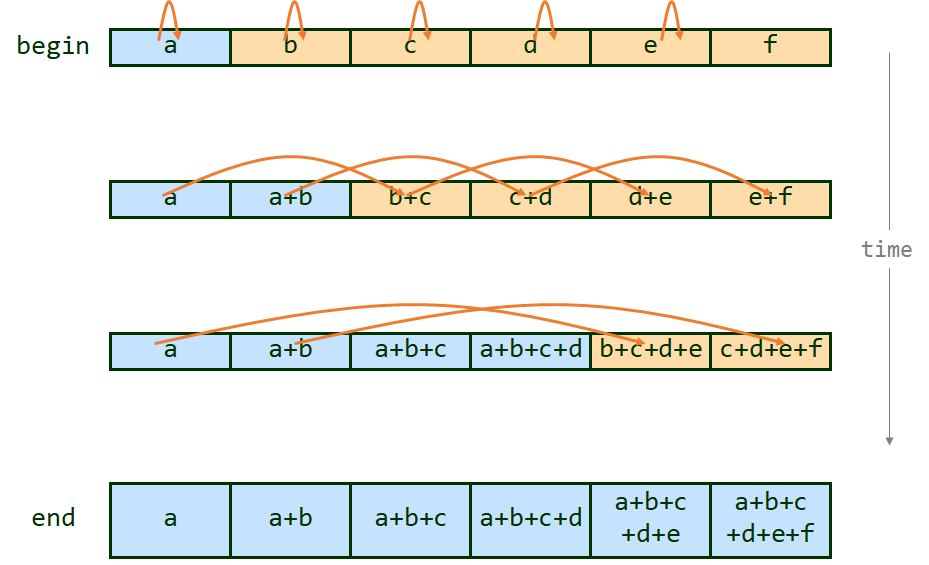
The goals of this assignment are:
In this assignment, you will implement a work-efficient parallel prefix sum algorithm using the pthreads library and a synchronization barrier you will write yourself. We encourage you to think carefully about the various corner cases that exist when implementing this algorithm, and challenge you to think about the most performant way to synchronize a parallel prefix sum depending on its input size.

Parallel prefix sum has come up a number of times so far in the course, and will come up again. It is a fundamental building
block for a lot of parallel algorithms. There are good materials on it in Dr. Lin's textbook, and the treatment of it you can
find on Wikipedia comes with reasonable pseudocode (see here).
Note that
The first step with any parallelization is to develop a sequential version to serve as a baseline both for performance and correctness.
It is generally easier to get the algorithm right without parallelism, and you need a sequential version anyway to measure against
so you can tell if your parallel implementation is performance-profitable. The command line parameters we would like your implementation
to support are listed in the "Inputs/Outputs" section below. We ask that you implement your sequential version
to be called when your program is invoked when the number of threads specified on the command line is 0 (-n 0). Note that
using a single pthread (-n 1) is not the same, as it involves all the overheads of thread creation and teardown that would
not be present in a truly sequential implementation.
Be sure your sequential implementation is correct before proceeding to parallelization!
Recall that prefix sum requires a barrier. In this step, you will write a work-efficient parallel prefix sum using pthread barriers. For each of the provided input sets, graph the speedup of your parallel implementation over a sequential prefix sum implementationi as a function of the number of worker threads used. Vary from 2 to 32 threads in increments of 2. Then, explain the trends in the graph. Why do these occur? If your speedup is not ideal, what overheads are causing your implementation to underperform an "ideal" speedup ratio?
In this step you will build your own re-entrant barrier. Recall from lecture that we considered a number of implementation strategies and techniques. We recommend you base your barrier on pthread's spinlocks, but encourage you to use other techniques we discussed in this course. Regardless of your technique, answer the following questions: how is/isn't your implementation different from pthread barriers? In what scenario(s) would each implementation perform better than the other? What are the pathological cases for each? Use your barrier implementation to implement the same work-efficient parallel prefix sum. Repeat the measurements from part 2, graph them, and explain the trends in the graph. Why do these occur? What overheads cause your implementation to underperform an "ideal" speedup ratio?
How do the results from part 2 and part 3 compare? Are they in line with your expectations? Suggest some workload scenarios which would make each implementation perform worse than the other.
The first line of the input file will contain a single integer i denoting the number of integers in the remainder input file. The following i lines will each contain a single integer, representing one integer in the input array. Your program should read in these i integers, compute their prefix sums, and print the sums to the specified output file, with a single integer on each line. Note: there should be i lines in your output file.
Your source code should include a Makefile which produces your executable by simply running make in the top-level directory of your submission. The executable should be named "pfxsum" and must accept the above arguments exactly as they are described. It is critically important you follow the build conventions and command line requirements exactly, as we will test and measure your code using automated tools that expect your executable and command line options to be specifically as described above.
Your solution should output the execution time in seconds to stdout, and no other output. It is fine to produce other output on stdout as long as it is disabled by default, either at compile time (using macros) or at runtime (using an extra/optional command-line flag).
When you submit your solution, you should include the following:
Please report how much time you spent on the lab.